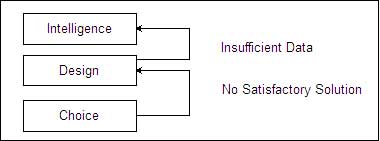Herbert Simon made key contributions to enhance our understanding of the decision-making process. In fact, he pioneered the field of decision support systems. According to (Simon 1960) and his later work with (Newell 1972), decision-making is a process with distinct stages. He suggested for the first time the decision-making model of human beings. His model of decision-making has three stages:
- Intelligence which deals with the problem identification and the data collection on the problem.
- Design which deals with the generation of alternative solutions to the problem at hand.
- Choice which is selecting the 'best' solution from amongst the alternative solutions using some criterion.
The figure given below depicts Simon's decision-making model clearly.
 |
| Simon's decision-making model |
Intelligence Phase:
- This is the first step towards the decision-making process. In this step the decision-maker identifies/detects the problem or opportunity. A problem in the managerial context is detecting anything that is not according to the plan, rule or standard. An example of problem is the detection of sudden very high attrition for the present month by a HR manager among workers. Opportunity seeking on the other hand is the identification of a promising circumstance that might lead to better results. An example of identification of opportunity is-a marketing manager gets to know that two of his competitors will shut down operations (demand being constant) for some reason in the next three months, this means that he will be able to sell more in the market. Thus, we see that either in the case of a problem or for the purpose of opportunity seeking the decision-making process is initiated and the first stage is the clear understanding of the stimulus that triggers this process. So if a problem/opportunity triggers this process then the first stage deals with the complete understanding of the problem/opportunity. Intelligence phase of decision-making process involves:
b. Problem Formulation
- Problem Searching: For searching the problem, the reality or actual is compared to some standards. Differences are measured & the differences are evaluated to determine whether there is any problem or not.
- Problem Formulation: When the problem is identified, there is always a risk of solving the wrong problem. In problem formulation, establishing relations with some problem solved earlier or an analogy proves quite useful.
- Design is the process of designing solution outlines for the problem. Alternative solutions are designed to solve the same problem. Each alternative solution is evaluated after gathering data about the solution. The evaluation is done on the basic of criteria to identify the positive and negative aspects of each solution. Quantitative tools and models are used to arrive at these solutions. At this stage the solutions are only outlines of actual solutions and are meant for analysis of their suitability alone. A lot of creativity and innovation is required to design solutions.
- It is the stage in which the possible solutions are compared against one another to find out the most suitable solution. The 'best' solution may be identified using quantitative tools like decision tree analysis or qualitative tools like the six thinking hats technique, force field analysis, etc.
- This is not as easy as it sounds because each solution presents a scenario and the problem itself may have multiple objectives making the choice process a very difficult one. Also uncertainty about the outcomes and scenarios make the choice of a single solution difficult.

0 comments:
Post a Comment